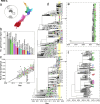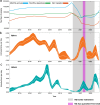Spatial and temporal transmission dynamics of respiratory syncytial virus in New Zealand before and after the COVID-19 pandemic
- PMID: 39528493
- PMCID: PMC11555088
- DOI: 10.1038/s41467-024-53998-5
Spatial and temporal transmission dynamics of respiratory syncytial virus in New Zealand before and after the COVID-19 pandemic
Abstract
Human respiratory syncytial virus (RSV) is a major cause of acute respiratory infection. In 2020, RSV was eliminated from New Zealand due to non-pharmaceutical interventions (NPI) used to control the spread of SARS-CoV-2. However, in 2021, following a brief quarantine-free travel agreement with Australia, there was a large-scale nationwide outbreak of RSV that led to reported cases more than five-times higher than typical seasonal patterns. We generated 1470 viral genomes of both RSV-A and RSV-B sampled between 2015-2022 from across New Zealand. Using a phylodynamics approach, we used these data to better understand RSV transmission patterns in New Zealand prior to 2020, and how RSV became re-established in the community following the relaxation of COVID-19 restrictions. We found that in 2021, there was a large epidemic of RSV due to an increase in importations, leading to several large genomic clusters of both RSV-A ON1 and RSV-B BA9 genotypes. However, while a number of viral importations were detected, there was also a major reduction in RSV genetic diversity compared to pre-pandemic years. These data reveal the impact of NPI used during the COVID-19 pandemic on other respiratory infections and highlight the important insights that can be gained from viral genomes.
© 2024. The Author(s).
Conflict of interest statement
Figures




Update of
-
Spatial and temporal transmission dynamics of respiratory syncytial virus in New Zealand before and after the COVID-19 pandemic.medRxiv [Preprint]. 2024 Jul 16:2024.07.15.24310412. doi: 10.1101/2024.07.15.24310412. medRxiv. 2024. Update in: Nat Commun. 2024 Nov 11;15(1):9758. doi: 10.1038/s41467-024-53998-5. PMID: 39072023 Free PMC article. Updated. Preprint.
References
-
- Falsey, A. R., Hennessey, P. A., Formica, M. A., Cox, C. & Walsh, E. E. Respiratory syncytial virus infection in elderly and high-risk adults. N. Engl. J. Med.352, 1749–1759 (2005). - PubMed
Publication types
MeSH terms
Associated data
Grants and funding
LinkOut - more resources
Full Text Sources
Medical
Miscellaneous

